Recent fungicide registrations provide growers with a greater range of options to reduce yield losses caused by Rhizoctonia. However the cost of fungicides, variation in yield responses between seasons and lack of information on which soil openers provide the best yield responses are identified barriers to adoption especially in the low rainfall regions.
This paper reports on the current analysis of results of two projects that have been investigating the yield responses using Uniform® dual banded on the surface of the furrow (200ml/ha) and on the base of the furrow (200ml/ha) to evaluate under different soil openers (GRDC DAS00125/SAGIT S314), and the effects of sowing time and Pratylenchus neglectus on yield responses of Uniform® applied to control rhizoctonia root rot in wheat and barley (SAGIT S215).
In 2015, trials were established at Geranium and Moorlands, South Australian Murray Mallee, to evaluate yield losses caused by rhizoctonia root rot with different soil openers (Table 1). A randomised split plot design with six replicates was used. Uniform® was split banded at 200ml/ha on the surface of the furrow and 200ml/ha at the base of the furrow for all treatments except one where the full rate was banded at the base of the furrow. Sites were selected with a history of rhizoctonia root rot, previous crops were cereals and with medium to high pre-sowing Rhizoctonia levels as reported by PreDicta B®.
Plots were fertilised with a 1:1 mix Granulock® Z and Gran-Am® at 85kg/ha (12N+9P+12S) applied with seeds for single shoot systems or deep banded with double shoot systems (Table 1). At both sites, all plots were planted with Grenade CL Plus wheat. The Geranium site was sown on the May 12 with a targeted seeding depth of 3cm and seeding rate of 78kg/ha. Post emergent N was applied at 40kg urea/ha in first week of July. The Moorlands site was sown on the May 21 at a depth of four centimetres at a seeding rate of 85kg/ha and post emergent N plus micronutrients were applied on August 10.
The trials were sown by the University of South Australia using a research plot seeder set up to deliver the fungicide treatments to one half of the plots (i.e. three out of six rows). All treatment runs thus comprised a no-fungicide reference within to enable accurate fungicide assessment suited to the patchiness of rhizoctonia root rot. A zero-fungicide control plot was also used to assess any plot seeder bias.
| Treatment |
Sakura® herbicide |
Depth of till (mm) |
Fertiliser |
Fungicide Application |
Speed (km/h) |
|---|
| Knife point |
Yes |
100 |
Deep banded |
Split In Furrow/Surface |
6 |
| AtomJet |
Yes |
50 |
Combined |
Split In Furrow/Surface |
6 |
| Bent-leg |
Yes |
130 |
Combined |
Split In Furrow/Surface |
6 |
| Single disc |
Yes |
60 |
Combined |
Split In Furrow/Surface |
11 |
| Single disc |
Yes |
60 |
Combined |
In Furrow only |
11 |
| Single disc |
No |
60 |
Combined |
Split In Furrow/Surface |
11 |
| Triple disc |
Yes |
100 |
Deep banded |
Split In Furrow/Surface |
11 |
| Triple disc |
Yes |
100 |
Deep banded |
Split In Furrow/Surface |
6 |
| Triple disc |
No |
100 |
Deep banded |
Split In Furrow/Surface |
6 |
| Triple disc + Scoop |
Yes |
100 |
Deep banded |
Split In Furrow/Surface |
4.2 |
| Knife point |
Yes |
100 |
Deep banded |
NONE (seeded control) |
6 |
Time of sowing, crop and Pratylenchus effects on Rhizoctonia fungicide yield responses
In 2014, a trial was established at Wilkawatt, SA, to generate adjacent plots of low and high Pratylenchus neglectus densities using Fusion triticale (resistant) and Estoc wheat (susceptible). This trial was established to assess named varieties for tolerance to P. neglectus but high levels of Rhizoctonia made it too risky to use as a nematode tolerance trial.
With support from SA Grain Growers Industry Trust (SAGIT) funding (project code S215) the site was used to study some of the factors that may affect the yield responses to Uniform® applied to control Rhizoctonia. A factorial trial design was used with each treatment combination replicated five times; time of sowing and fungicide application were blocked. Treatments included barley (Scope) and wheat (Grenade CL Plus), 2 P. neglectus densities (2 range 0-4 and 10 range 2-20 nematodes/g soil), with ±Uniform® fungicide and three dates of sowing (TOS) (6/5/15, 22/5/15 and 11/6/15). Uniform® was applied as a dual treatment on the furrow surface (200ml/ha) and in furrow (200 ml/ha). All plots received Di-Ammonium Phosphate (DAP) at 50kg/ha coated with Flutriafol; Boxer Gold® was applied at seeding to control ryegrass.
Each plot was soil sampled on the row of the previous crop prior to sowing in May, on and between the rows in August and October and on row post-harvest in November. Rhizoctonia and P. neglectus levels were measured at each sampling time using the SARDI PreDictaB® DNA soil testing service. The wheat and barley DNA concentrations measured mid-season provided an assessment of root growth. The site was harvested in late November and yields of each plot measured. Data was analysed by Dr Ray Correll of RHO Environmetrics.
Results and discussion
Seasonal conditions
The 2014 season had a relatively dry and cold start with Wilkawatt being slightly drier and colder than Geranium. These conditions probably contributed to the greater patching at Wilkawatt (Figure 1 and 2). Growing season rainfall totalled 114mm and 145mm at Wilkawatt and Geranium respectively (Figure 2). The September to October rainfall at each sites was 27mm and 42mm respectively. The large rain events in early November were too late to benefit yield and are not included as part of the growing season total.
Soil opener trial at Geranium
Averaged across all treatments the fungicide reduced Rhizoctonia levels by 52 per cent and 57 per cent on-row in August and October respectively (p<0.001) (Figure3); increased root growth by 67 per cent and 65 per cent in August and October respectively (p<0.001) (Figure 4); and increased wheat yield by 0.22t/ha (p<0.001) (Figure 5). Had there been more spring rainfall yield responses would probably have been greater.
The fungicide responses were consistent across the soil openers except for the experimental bent-leg opener, which showed no significant fungicide effect on Rhizoctonia levels, wheat root growth in August, or on grain yield (Figure 3, 4 and 5).
Removing the top three to four centimetres of soil (which contains about 75% of Rhizoctonia inoculum) away from the seeding furrow using a scoop in front of the triple disc did not produce any disease or yield benefits, however it did significantly improve crop establishment in a duplicate trial at Moorlands which had non-wetting sand (yield at this site was severely affected by frost).
The highest yielding treatments at Geranium, all with fungicide, included knife point, narrow point (Atomjet) and triple disc. The best openers without fungicide were bent-leg, knife point and triple disc. The effect of the bent-leg warrants further investigation.
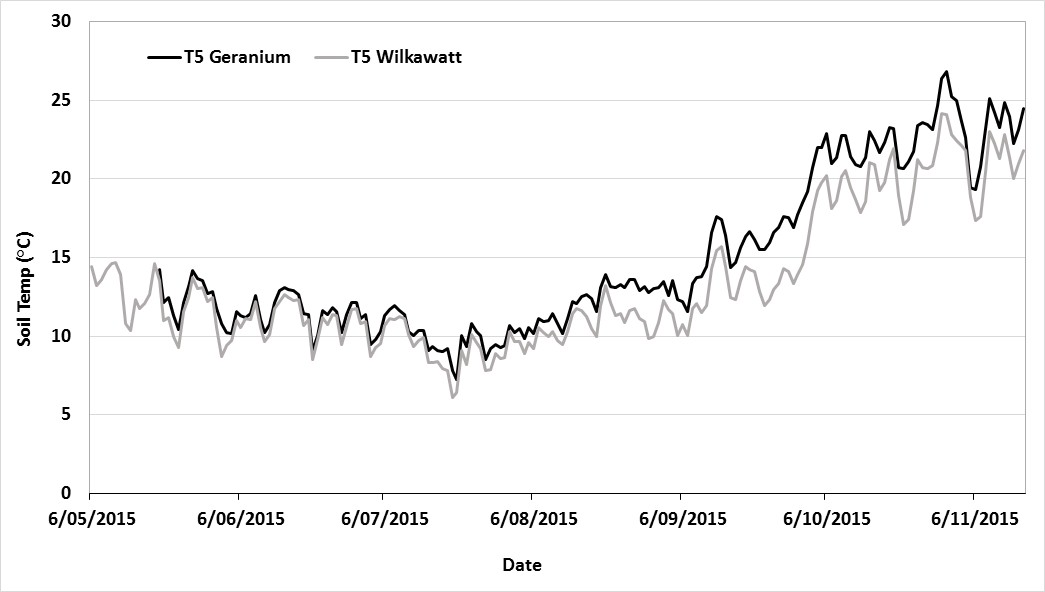
Figure 1: Soil temperatures at five centimetres at Geranium and Wilkawatt trials 2015.
Early in the growing season soil temperatures dropped below 10°C regularly at Wilkawatt. Soil temperatures at Geranium were consistently warmer than at the Wilkawatt trial. Rain often fell on the same day at both sites and the amount was often greater at the Geranium trial compared with the Wilkawatt trial (note records started two weeks later at Geranium).
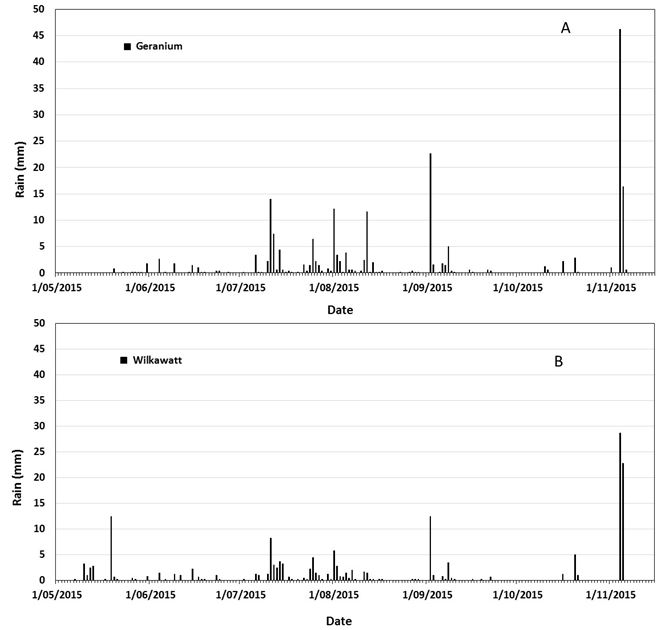
Figure 2: Growing season rainfall at A Geranium and B Wilkawatt in 2015. Note the crops had matured before the large rain events in early November.
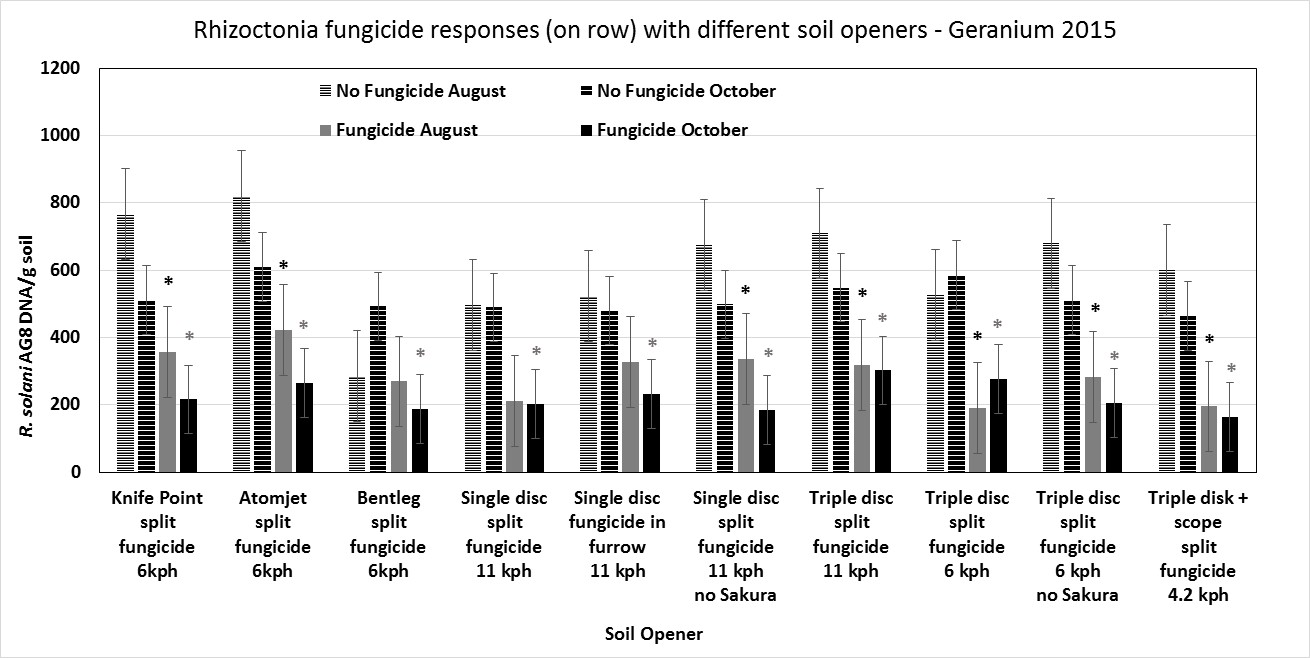
Figure 3: Effect of soil opener on Rhizoctonia solani AG8 density on row +/- fungicide at Geranium in August 2015, * fungicide response significant at p<0.05 and ** p<0.001, (bars are standard errors SE).
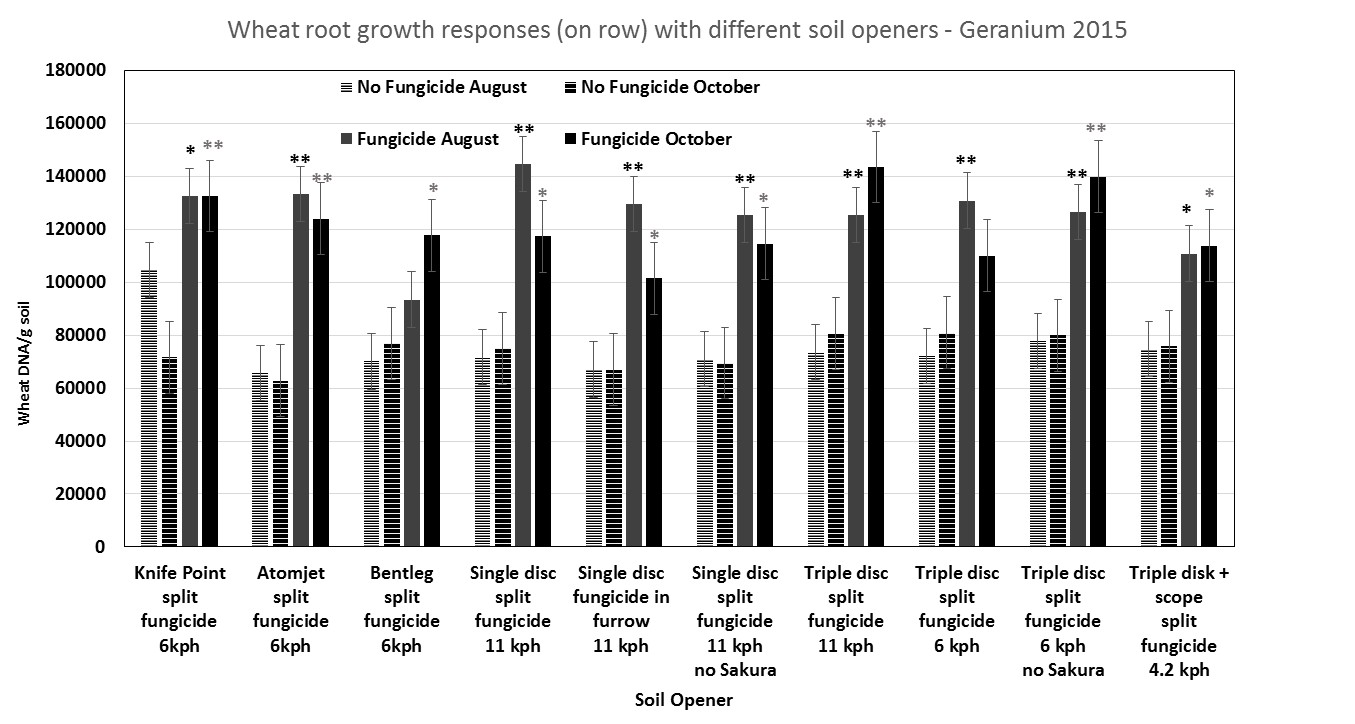
Figure 4: Effect of soil openers +/- fungicide on wheat root growth on row at Geranium in October 2015 (bars are standard errors SE).
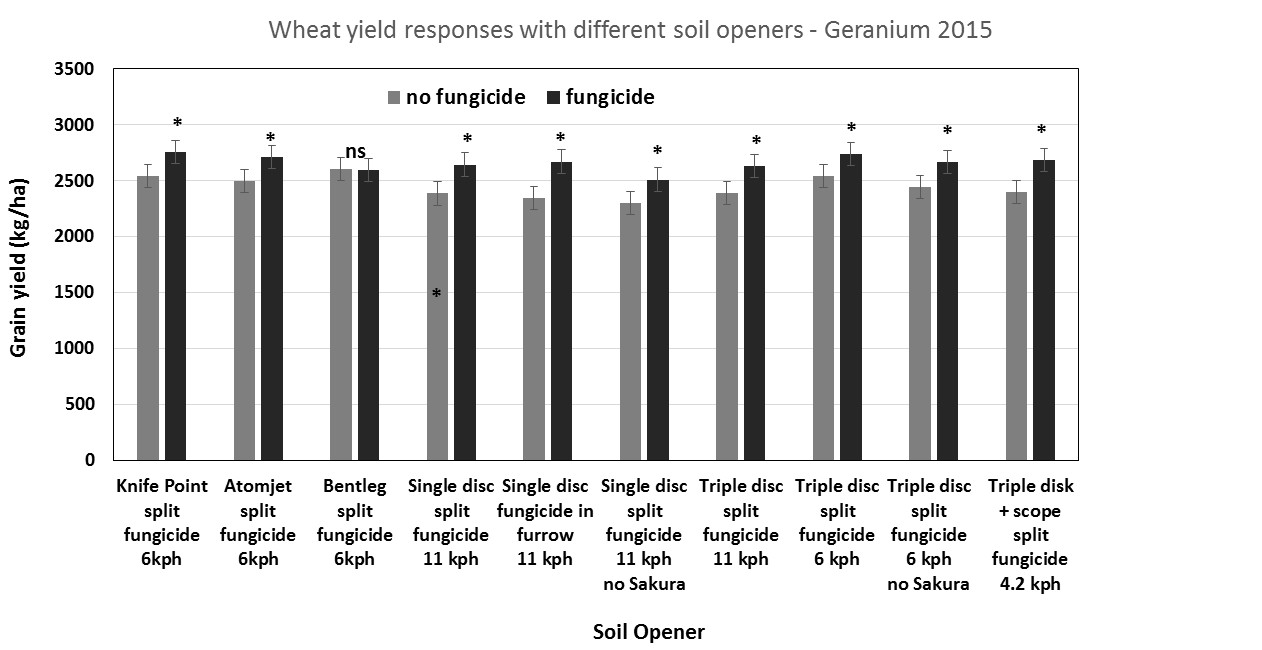
Figure 5: Soil openers yield responses +/- fungicide at Geranium 2015 (bars are standard errors).
Effect of time of sowing, P. neglectus and fungicide on barley and wheat yield at Wilkawatt 2015
Patching at the Wilkawatt site in wheat and barley at all sowing times was worse than at Geranium (and at Moorlands). Soil temperatures and moisture levels at Wilkawatt were lower than at Geranium. These were probably important contributing factors. (The key environmental triggers for expression of patches warrants further investigation).
Despite the early patching, yields were greatest for both crops at TOS 1, with barley yield greater than wheat and the lowest yields at TOS 3 (Figure 6). Fungicide application increased yield significantly in barley, especially at TOS 2 which produced a 0.65t/ha response. The fungicide yield responses in wheat were not significant, despite significant increases in root growth which persisted into October (Figure 7). So the relatively small yield responses especially in wheat were most likely due to low spring rainfall.
When pre-sowing Rhizoctonia levels were included as covariates in the yield analysis they eliminated the fungicide yield responses and greatly reduced the root growth responses. This implies the fungicide effect can be explained by reduced Rhizoctonia levels.

Figure 6: Yield responses of A Scope barley and B Grenade CL Plus wheat +/- fungicide at early, mid and late season sowing times at Wilkawatt 2015 (bars are standard error of difference, SED).

Figure 7: Main effects of fungicide banded at seeding on root growth in A Scope barley and B Grenade CL Plus wheat assessed in August and October at Wilkawatt 2015 measured by root DNA concentrations in soil (bars are standard error of difference, SED).
The application of fungicide decreased Rhizoctonia levels by more than 30 per cent in both crops in August and October (Figure 8 A&B). By November the reduction had increased to more than 40 per cent which means a potentially useful reduction in inoculum carried into the next season compared to the untreated plots.
Overall, barley supported higher Rhizoctonia levels compared to wheat (Figure 8A&B) indicating that barley is more susceptible, i.e. a better host.

Figure 8: Effects of banding liquid fungicide at seeding on Rhizoctonia solani AG8 levels in A Scope barley and B Grenade CL Plus wheat in August, October and post-harvest (November) at Wilkawatt 2015 measured by soil DNA concentrations in soil (bars are standard error of difference, SED).
At a previous trial at Lameroo, SA, in 2014, there was a negative relationship between P. neglectus on the yield gain of CL Grenade wheat due to fungicide. For each additional P. neglectus per g soil above five, yield gain declined by 10.3kg/ha.
At Wilkawatt in 2015, P. neglectus multiplication was significantly greater in the Grenade wheat plots than Scope barley, and multiplication was greatest in the TOS1 treatments and reduced significanlty as sowing time was delayed (Figure 9).
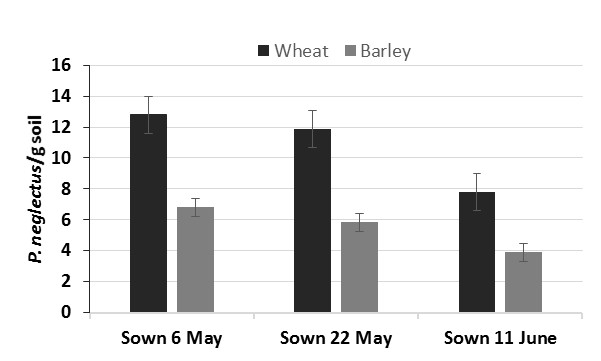
Figure 9: Pratylenchus neglectus levels at different times of the year on row of Grenade CL Plus wheat and Scope barley at Wilkawatt 2015 (bars are standard error of difference, SED).
The potential interaction between P. neglectus and Rhizoctonia in the Wilkawatt 2015 trial is still being examined. The triticale and wheat crops grown at that site in 2014 to produce paired low and high P. neglectus populations appear to have affected crop yields in 2015, so the nematode effects may be compromised. Work is progressing to correlate the natural variation in the pre-sowing levels of P. neglectus with individual plot yields, grouped by the low and high nematode treatments to remove the crop setup effects. Initial results indicate there are significant negative relationships between initial P. neglectus levels and yield.
Conclusions
- Analysis and interpretation of this data is continuing. There were many significant effects, interactions and correlations. Results presented in this paper summarise the main findings so far
- Application of fungicide to control Rhizoctonia in wheat and barley is likely to produce the greatest yield responses when there is significant spring rainfall. In seasons with low spring rainfall, yield responses are likely to be greatest in barley crops sown within the optimum seeding window compared to wheat
- Application of Uniform® at seeding as a dual band on furrow surface (200ml/ha) and at the base of furrow (200ml/ha) increased root growth by more than 50 per cent in wheat and barley in the top 10cm within the row and the magnitude of the response was maintained or increased as the season progressed. Roots were protected only within the fungicide treated zone and not between the rows
- Average yield responses in the plus fungicide treatments at Wilkawatt and Geranium did not reflect the improved root growth which was often >50 per cent. The low yield responses were probably due to low spring rainfall which totalled 27mm and 42mm at Wilkawatt and Geranium respectively
- Wheat is more tolerant to Rhizoctonia than barley, with fungicide yield responses in wheat typically 60 per cent of those in barley. Rhizoctonia levels following barley are also greater than after wheat
- Knife point, triple disc and bent-leg soil openers that disturb soil to at least 10cm with seed sown about 3cm deep produced the greatest yield minus fungicide in Rhizoctonia trials at Geranium in 2015. Knife point, narrow point (Atomjet) and triple discs produced the greatest yield when Uniform® was dual banded at 200ml/ha behind the press wheel and 200ml/ha on the base of the furrow increasing wheat yield by 0.22t/ha. A duplicate trial at Moorlands in 2015 was lost to frost. Similar yield responses were observed in previous trials conducted in 2014
- Pratylenchus neglectus multiplication on wheat was greater than on barley and declined as time of seeding was delayed. Work is progressing on the effects of P. neglectus on yield and its interaction with Rhizoctonia
- Uniform® dual banded increased yield by a similar amount with all soil openers except the bent-leg opener (the bent-leg had the lowest Rhizoctonia levels in August, but levels were similar to other openers in October)
- Further work is needed to better understand treatment responses in different seasons, interactions with other diseases and farm practices including post emergent N application, this information will assist growers to identify the situations where they will get a positive return on investments to control Rhizoctonia.
Useful resources
Acknowledgments
GRDC and SAGIT for funding the research (SAGIT project codes S314, S215). SARDI New Crop Agronomy group for managing weed control and harvesting the trials. All the growers that kindly allowed SARDI to conduct the trials on their land.
Contact details
Alan McKay
SARDI









